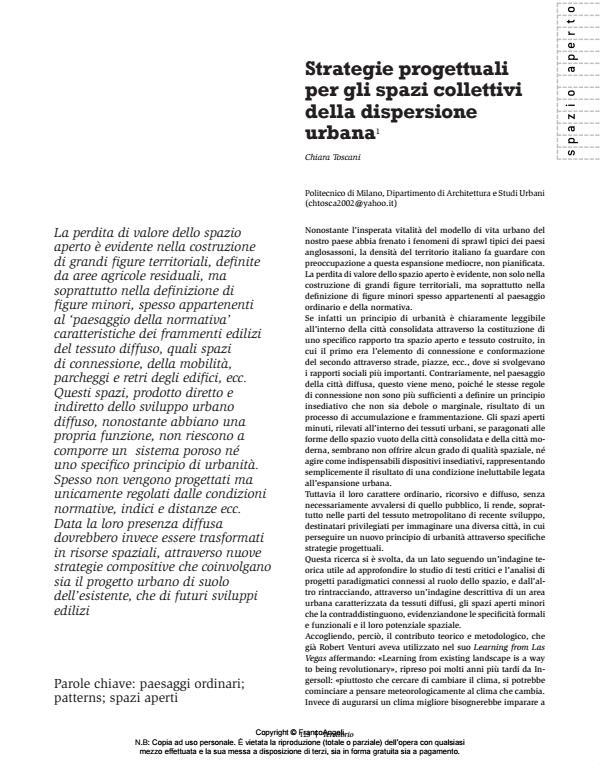Planning strategies for the collective spaces of urban scatter
Journal title TERRITORIO
Author/s Chiara Toscani
Publishing Year 2014 Issue 2013/67 Language Italian
Pages 10 P. 123-132 File size 1439 KB
DOI 10.3280/TR2013-067021
DOI is like a bar code for intellectual property: to have more infomation
click here
Below, you can see the article first page
If you want to buy this article in PDF format, you can do it, following the instructions to buy download credits

FrancoAngeli is member of Publishers International Linking Association, Inc (PILA), a not-for-profit association which run the CrossRef service enabling links to and from online scholarly content.
The loss in the value of outdoor space is clearly seen in the construction of large ‘territorial figures’, defined by residual agricultural areas, but above all in the definition of smaller figures, often belonging to the ‘regulatory landscape’, characteristics of built fragments of the diffuse urban fabric, such as connecting spaces, mobility, parking spaces and the backs of buildings etc. Although these spaces, the direct and indirect product of diffuse urban development, have their own function, they succeed in the composition of neither a porous system, nor a specific urban principle. Often they are not planned, but only regulated by legal conditions, indexes and distances etc. However, in view of their diffuse presence they should be transformed into spatial resources by means of new strategies for composition that involve both urban plans for existing land and for future building developments.
Keywords: Ordinary landscapes; patterns; outdoor spaces
- Aa.Vv., 2002, La città Europea del XXI secolo, Skira, Milano.
- Aa.Vv., 2005, Sense of the City, an Alternative Approach to Urbanism, Lars Muller Publishers, Baden, Swiss.
- Aa.Vv., 2009, Recycle, Electa, Milano.
- Aa.Vv., 2011, «Strategy and Tactics in Public Space», A+T, n. 38, A+T architecture publisher, Spain.
- Alexander C., 1977, A Pattern Language, Oxford U.P., New York.
- Acebillo J., 2012, A New Urban Metabolism, AB Publisher, Mendrisio- Barcelona.
- Bauman Z., 2006, Modernità liquida, Laterza, Bari.
- Becker J., 2008, What we can do with the City, Boom Onderwijs, Amsterdam.
- Berger A., 2006, Drosscape, Princeton Architectural Press, New York.
- Bishop P., Williams L., 2012, The Temporary City, Routledge, London.
- Bourriaud N., 2010, Estetica Relazionale, Postmedia, Milano.
- Bowmn A., Pagano A., 2004, Terra incognita, George Town Press, Washington D.C.
- Careri F., 2006, Walkscape, Einaudi, Torino.
- Choay F., 2006, Espacement, Skira, Milano.
- de Sola Morales E., 1999, Città Tagliate, Lotus Quaderns, Electa, Milano.
- Di Giovanni A., 2010, Progetto urbanistico e vita in pubblico nella città contemporanea, Carrocci, Roma.
- Duany A., Plater-Zyberk E., Spech J., 2000, Suburban Nation, North Point Press, New York.
- Eran Ben J., 2012, Rethinking a Lot, Mitpress, Boston.
- Ferrario V. e Sardena A., 2010, Forme recenti del processo di urbanizzazione, Quaderni del Brenta, Centro Studi del Brenta.
- Idenburg F., 2010, Relations in the Architecture of Kazuyo Sejima + Ryue Nischizawa, Postmedia, Milan.
- Ingersoll R., 2006, Sprawltown, Meltemi, Roma.
- Koolhaas R., 2006, Junkspace, Quolibet, Macerata.
- Lanzani A., 2008, I paesaggi italiani, Molteni, Roma, 2008.
- Lanzani A., 2011, In cammino nel paesaggio, Carrocci, Roma.
- Lucan J., 1993, «Lo spazio urbano nell’era dell’individualismo», Casabella, n. 597, pp. 77-79.
- Macchi Cassia C., 2004, Per Milano, Hoepli, Milano.
- Munoz F., 2008, Urbanalizaciòn, GGmixta, Barcelona.
- Pellegrini P., 2010, Le trasformazioni della città diffusa del Veneto centrale. Premessa per la riconcettualizzazione del sistema della mobilità del territorio, rapporto tecnico, Iuav, Venezia.
- Rowe C., Koetter F., 1984, Collage City, Mit Press, Massachusetts.
- Repishti F., 2001, «Oltre il giardino», Lotus, n. 110, pp. 102-111.
- Teyssot G., 2001, «Il prato Americano, luogo della vita quotidiana», Lotus, n. 101, pp. 92-116.
- Temel R., 2006, Temporary City, Birkhauser, Zürich.
- Viganò P., 1999, La citta elementare, Skira, Milano.
- Van Gamerend D., Theunissen K., 2009, New Open Space in Housing Ensembles, Nai Publisher, Netherland.
- Venturi R., 1977, Learning From Las Vegas, Mitpress, Boston.
- Zardini M., 2008, «A New Urban Takeover», in Borasi G. and Zardini M. (eds.), Actions: What you can do with the City, Sun Publisher, Montreal.
Chiara Toscani, Strategie progettuali per gli spazi collettivi della dispersione urbana in "TERRITORIO" 67/2013, pp 123-132, DOI: 10.3280/TR2013-067021